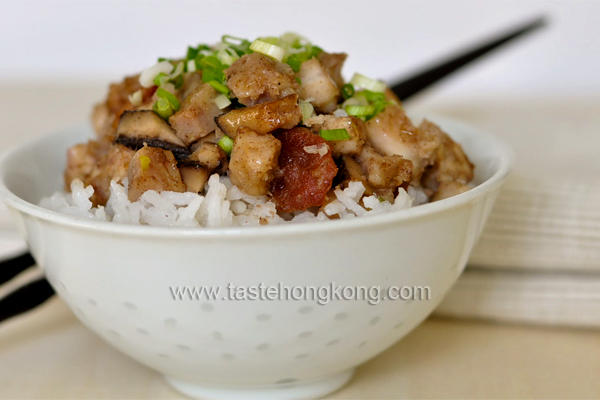
Some called this Baked Taro Rice (焗芋頭飯 in Chinese). It doesn’t mean that the dish is baked in oven but in effect the taro is steamed directly over rice in a pot (usually a clay pot), covered. Happily, I find it equally good to cook this with a rice cooker but with minimal effort.
I had not even attended the boiling rice until my timer beeped, when I timed to add the rest of ingredients to it. Thanks to my rice cooker, I could steal some extra lazy moments.
Whether using a pot or a rice cooker for making this, water has to be added to the rice as usual. Cooked to the boiling point, rice absorbs more and more water and steams emits. As most water were gone, I added taro, sausage, mushrooms, etc onto the rice. Covered again; with added ingredients, the steam at the same time infused flavors to the rice. Essentially, it is ‘covered and steamed’ together brings about the notion of ‘baked’ taro rice, but technically it is different from the traditional steaming where there is a pool of water underneath.
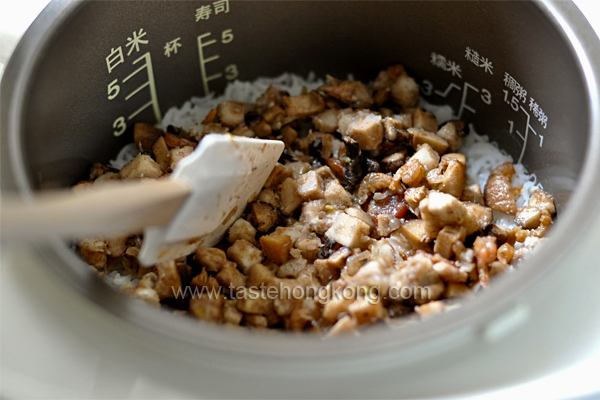
In Chinese cuisine, taro is often cooked with different meats. One popular version of this recipe includes ground or diced pork or chicken. Here, I have a Chinese sausage direct from my fridge therefore skipping a step in marinading the meat.
The amount of taro included in this recipe shall be good for serving with roughly two cups of cooked rice, but I usually cook more. Because cooked taro is good to be stored in the fridge for a couple of days. And after steamed, it still looks if it is freshly made. I was really happy to find it sitting in my fridge particularly when my schedule didn’t allow elaborated cooking.
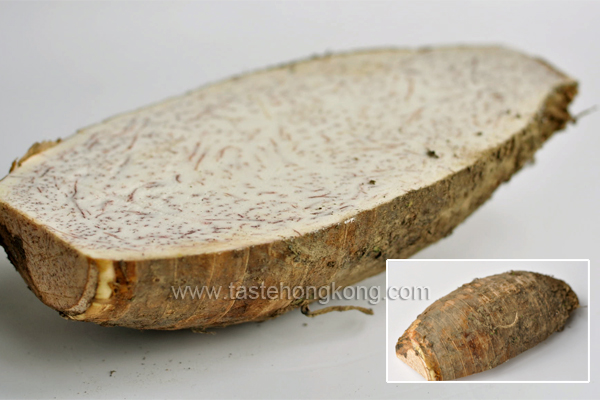
- Ingredients
- 150g rice
- 200g taro
- 1 Chinese sausage / Lap Cheong (臘腸), ~35g, thinnly sliced
- 4 dried black mushrooms
- 1 tbsp dried shrimps
- 2 shallots, finely sliced
- 1/4 cup water (or reserved from soaked mushrooms)
- 1 tbsp oil for stir frying
- 1 spring onion, finely sliced, optional
- soy sauce to taste
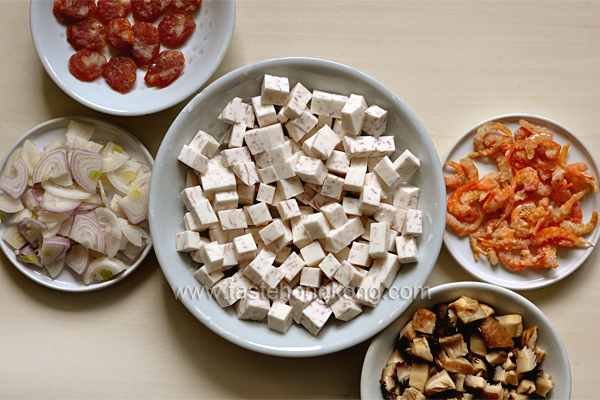
- Marinades for taro
- 1/2 tsp Chinese five-spice powder
- 1/2 tsp salt
- 1/2 tsp sugar
- 1/2 tsp sesame oil
- 1/8 tsp ground white pepper
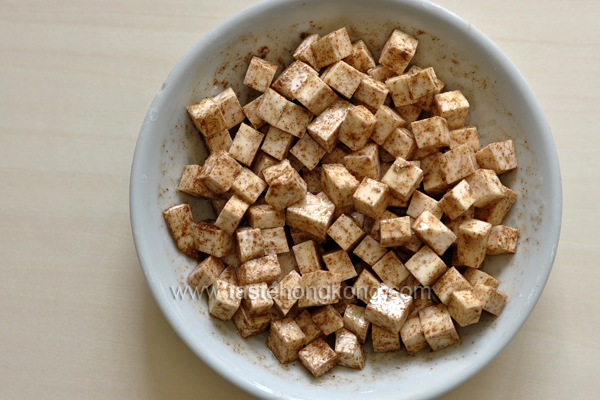
Method
Peel, rinse, and dice the taro, slightly thicker than half cm. Marinade for about 15 minutes.
Rinse dried mushrooms, soak until soft. Discard tough stems. Squeeze excess water from mushrooms after rehydrated. Dice into similar size of taro.
Rinse dried shrimps, soak until slightly soft. The ones I used is fairly small, so I let them sit in water for about 5 minutes only. Drain dry.
Heat oil over medium heat for stir-frying, sauté shallot, dried shrimps and sausage until fragrant, followed by mushrooms and taro. Stir and turn constantly for about a minute. Then add about a quarter cup of water, cover. Let simmer for 1 to 2 minutes (prolonged simmering may render the taro too mushy) or until liquid is almost reduced.
Rinse rice and cook it in cooker as usual.
Toward the last 10 minutes of rice cooking, open lid and quickly spread all stir-fried ingredients flat on top of the rice. Cover again. The sign of the right timing for adding taro is that the rice is slightly bubbling and looks wet with very little amount of water.
Continue to cook rice until done. Dish up, garnish with spring onion and add soy sauce to taste.
Serve hot and enjoy!
Note:
Taro vs yam
In Hong Kong, if you name taro as yam, very likely you will get another type of root called the Chinese yam (aka 淮山, nagaimo, or Japanese mountain yam), which is different from taro. But in some areas of S.E.Asia, the name of taro and yam seems to be interchangeable.
Peeling taro
It’s better to wear hand gloves because uncooked taro can cause itchy skin.
Amount of taro
Unlike baby taro, a mature taro usually weighs more than a kilogram, therefore you may need only half or a quarter of it.
- Category: Featured . Rice and Grain . Vegetable .
- 27 comments
To get immediate updates and new recipes from my blog, you may also SUBSCRIBE them via RSS feeds. See you there.
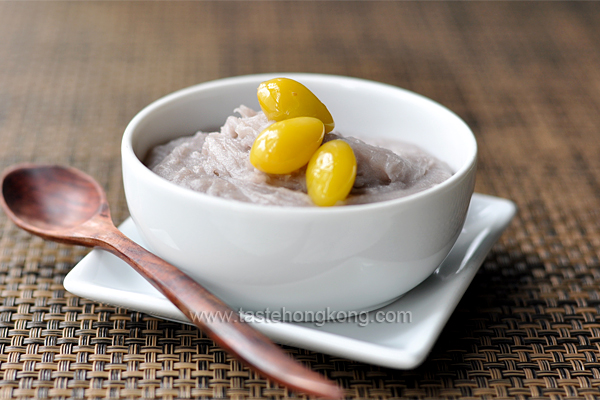
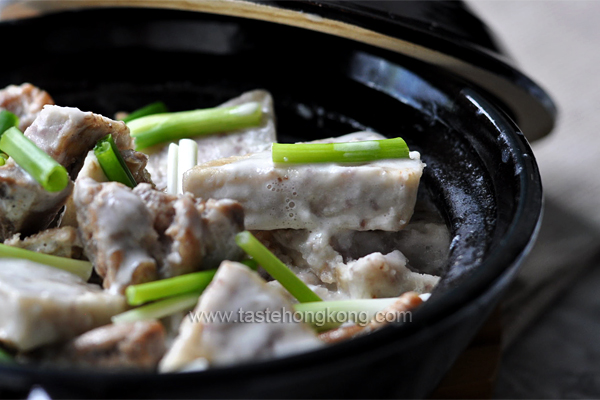
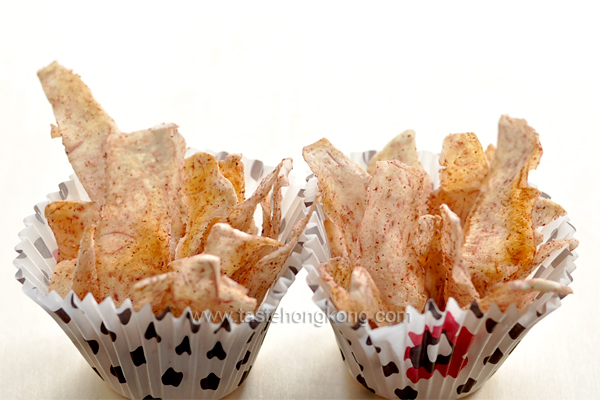
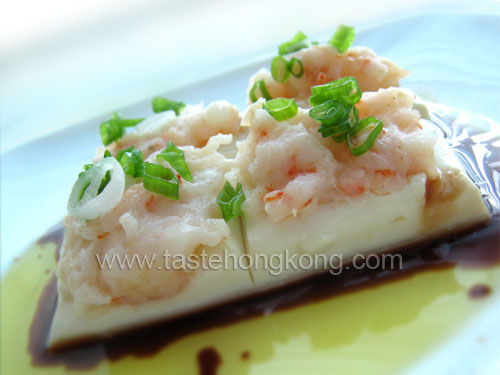
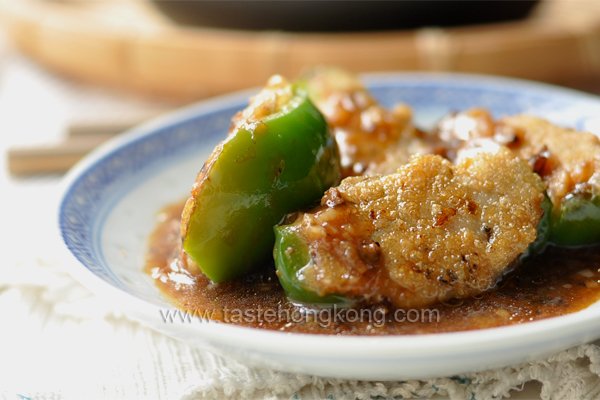
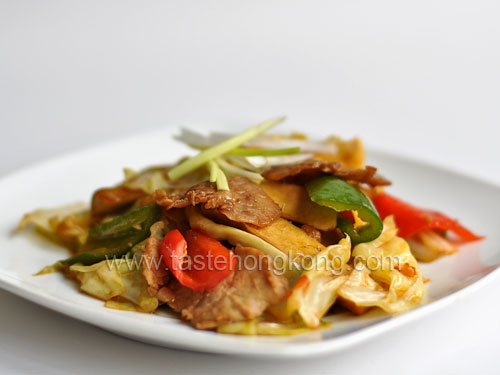
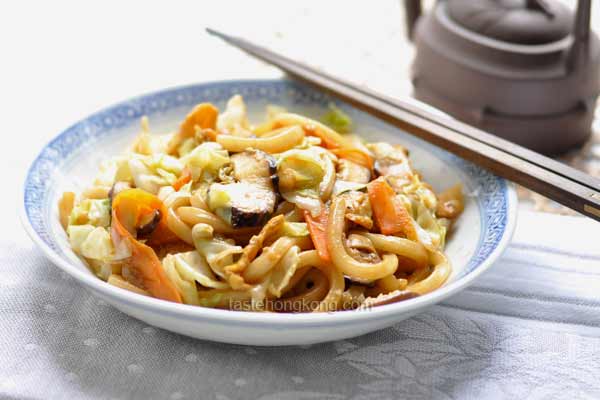
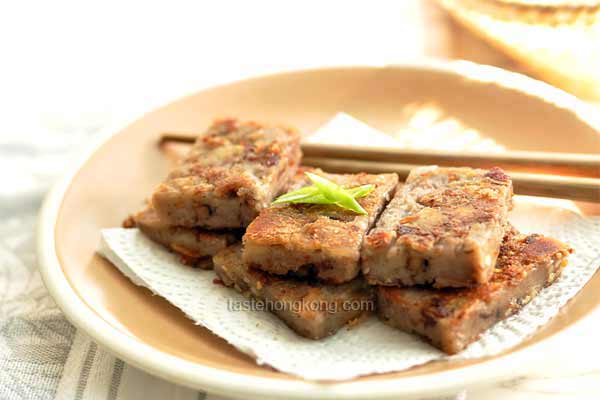
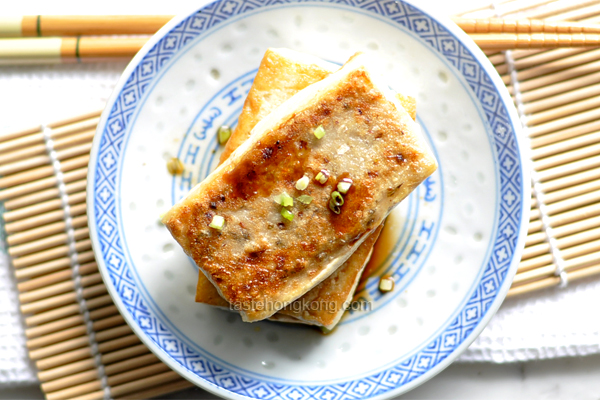
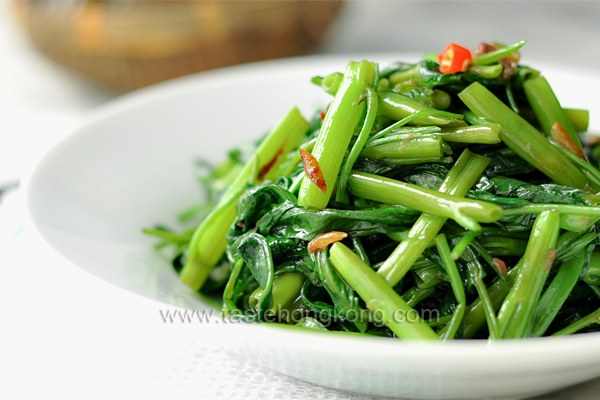
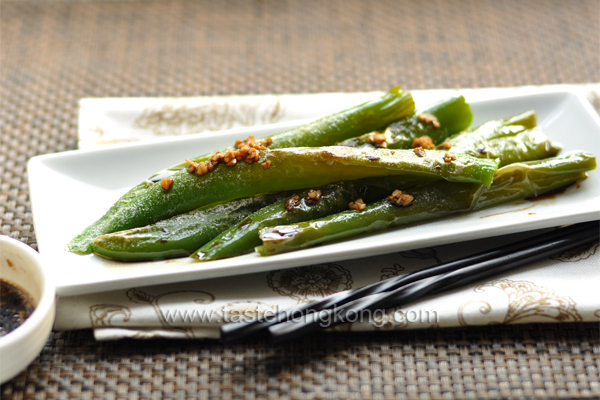



[…] this article: Taro or Yam Rice with Chinese Sausage | Blog about Recipes … Related Posts:Yaki Curry Rice (Baked Japanese Curry Rice with Cheese) | Lovely … Trackback […]
Love aroma of Chinese five spices!
The simplest 芋頭飯 with dried shrimps and mushrooms is enough to satisfy me. Now your 芋頭飯 with the other extra ingredients is calling me….the robust flavors, savory fragrance……oh too good!
I cook this in rice cooker too. It’s very simple to prepare this one-pot dish. 🙂
Normally I add roasted pork and lean pork strips to the rice, but I have not use Chinese sausage before.
Taro (or yam) is on my fav food list.
This is one of my fave one-dish meal. I usually add some char siu in mine too. Love your addition of Chinese sausage, mushrooms and 5-spice powder.
Now that is what I would love to have for dinner. Anything rice and I just love it but with bold flavors like that even better. I better get me a rice cooker. Yummy
I seriously miss quality floury taro…sighs….love them braised or stewed in a claypot..that’s my dream lunch!
I am from Hong Kong living in the U.S. I long for Hong Kong style Cantonese food recipes and glad to find your blog.
@Wendy,
Gladly, it makes no big differences where we reside when it comes to blogging. I shall also be happy to hear you reading and commenting my recipes of other cuisines, welcome back!
This Taro Rice with Chinese Sausage is my fave comfort dish in winter. Quick and delicious.
Love yam rice and yes in Malaysia taro and yam are interchangeable. In the US, it’s mostly taro. I love cooking in claypots too !
Oh! Next time that I get a hold of taro, will definitely make this dish…looks fabulous and totally calling my name 🙂
I like cooking stuff in my rice cooker as well. Not tried taro before. And never knew taro and chinese sausage will work. Will have to try this!
My grandma used to cook this a lot. She adds long beans too!
i want cry!, i don´t know how to cock it well, my food don´t taste the same as in china!!!
my destiny is not to be a cheff for sure.
@Nicolas,
Is there any thing I should clarify for this recipe? Let me know if you have problems in cooking this. Or you may choose to write to me at tastehongkong[at]gmail[dot]com.
I just made this for dinner and it was easy and delicious! Great comfort food for a cold winter day! Thank you for your detailed & yummy recipe!
@A.M.,
Thanks. This is one of the good news I receive at the beginning of 2011. Have fun cooking!
Re: Taro or Yam Rice with Chinese Sausage
Your recipe sounds yummy but from my experience taro cooking time can vary. How do you know if you have given enough time for the taro to cook in the rice cooker. I can’t wait to try it.
@Denise,
Right, larger piece of taro requires longer cooking time. I know it is done when I may pierce a chopstick easily through the center. For smaller ones like these, just pick one or two to check if the chopstick can mash or break them easily.
Experience also tells.
Enjoy soon!
i used to cook this.i my wife A,harn and i love yam rich very much.yummy.adding taro timing is afer rice cook 10min and it bubbling looks wet…is important…you can add vegetable if u like but not too much,,well,imiss it some time when i find taro.is my dream dinner,,really enjoy yam rice with my love one A.H..hv fun cooking….thank u for the recipes…or is my fav.food…
@colin,
You are welcome. I notice that you already know the method before you read this recipe.
Time to make this again as taro will be in season within a month, enjoy!
Thanks for writing.
Hi! I made this tonight and actually cooked it in a claypot (combining two of your recipes). It was delicious! The method section of the recipe doesn’t mention when to add the 臘腸 to the wok. I stir-fried the 臘腸 first in a little bit of oil (since it releases more oil), then added the rest of the ingredients. I also used a mixture of white and red rice (红米), and it looks beautiful.
@Ana C.
Thanks for testifying the clay pot version of this, and sharing your healthy adaptation with red rice. Sorry for missing out sausage in the method, it is now reverted, thanks!
Today, I cooked your yam rice and got the thumbs up from my family. Thank you so much!!!
@Emily,
Great! Thank you for your feedback!